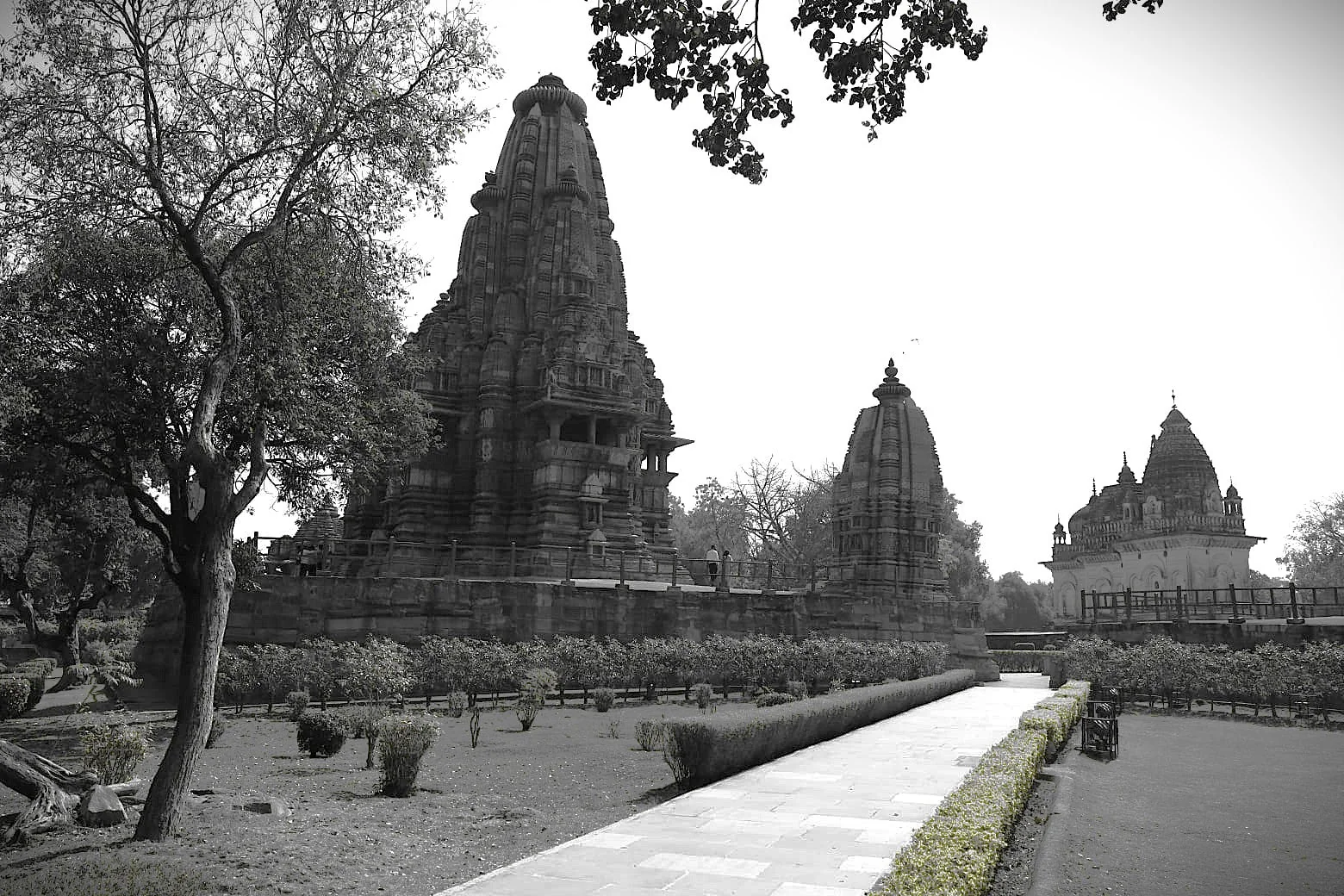Khajuraho – Part 3

Khajuraho: A Sacred Journey Through Time and Art (Part 3)
Nandi: The Divine Messenger

At many of Khajuraho’s Shiva temples, particularly the Vishvanatha Temple, you’ll encounter Nandi, the sacred bull who serves as Lord Shiva’s mount and gatekeeper. Carved from a single block of stone and positioned facing the sanctum sanctorum where Shiva resides, Nandi sits in eternal vigilance.

A beautiful tradition persists to this day—devotees approach Nandi and whisper their prayers directly into his ear. It is believed that Nandi faithfully transmits these messages to Lord Shiva. This practice creates an intimate connection between worshiper and deity, with Nandi serving as the compassionate intermediary.

The bull’s ears are often notably worn smooth from centuries of whispered prayers. When I observed pilgrims engaged in this practice, I noticed the profound reverence with which they approached Nandi—first circumambulating the figure, then bending to whisper their most heartfelt desires, fears, and gratitude into those patient stone ears.

One elderly woman spent several minutes in this communion, tears streaming down her face as she shared what appeared to be deeply personal matters with the divine messenger. The faith that Nandi would faithfully convey her words to Shiva was palpable, a beautiful demonstration of the living tradition these temples continue to foster.

The Western Group: Masterpieces of Sacred Architecture
The Western Group of temples represents the pinnacle of Khajuraho’s architectural achievements. Among these, the Kandariya Mahadeva Temple stands supreme—dedicated to Lord Shiva, it rises 31 meters high and features over 870 exquisitely carved sculptures.

The temple’s name “Kandariya” refers to cave-dwellers, connecting it to Shiva’s association with mountain caves. Its shikhara (spire) resembles a series of mountains rising toward the sky, symbolizing the cosmic mountain and spiritual ascension. The temple’s proportions follow precise mathematical ratios believed to align with cosmic harmonies.

As you enter the Kandariya Mahadeva Temple, you move through progressively darker and more confined spaces, representing the journey from the outer world of appearances to the inner realm of spiritual truth. The mandapa (hall) features intricately carved pillars with bracket figures that seem to emerge from the stone itself, supporting the weight of the roof both physically and symbolically.

The Lakshmana Temple nearby presents another architectural masterpiece, dedicated to Vishnu. Built in 954 CE, it features a remarkable panel showing the creation myth of the churning of the cosmic ocean. The sculptural detail is so precise that you can identify individual deities and asuras (demons) pulling on the cosmic serpent, with Lord Vishnu at the center maintaining cosmic balance.
The Vishvanatha Temple, dedicated to Shiva, houses one of the most revered Nandi statues in Khajuraho. The temple’s design integrates squares and octagons in its layout, representing the meeting of earthly and celestial realms. Its sanctum contains a powerful lingam (the aniconic representation of Shiva) that continues to receive ritual offerings.
The Eastern and Southern Groups: Hidden Treasures
While the Western Group receives the most attention, the Eastern and Southern Groups offer their own architectural marvels—often in more peaceful settings away from tourist crowds.
In the Eastern Group, the Parsvanatha Temple stands as the largest Jain temple in Khajuraho, featuring exceptional sculptures of Jain Tirthankaras (enlightened beings). These figures exhibit a distinctive meditative serenity, with downcast eyes and subtle smiles that convey profound inner peace. The temple demonstrates how different religious traditions coexisted harmoniously in medieval India, sharing architectural styles while maintaining their distinct spiritual identities.

The nearby Javari Temple, though smaller, contains some of Khajuraho’s most precise carvings. Its outer wall features a remarkable depiction of celestial dancers with such fluid movement that they seem to defy the stone medium from which they’re carved.
In the Southern Group, the Duladeo Temple dedicated to Shiva as the “Holy Bridegroom” contains particularly graceful sculptures of celestial nymphs. The carving technique here achieves an almost three-dimensional quality, with figures that appear to step out from the wall surface.
Symbolic Meaning and Spiritual Significance

Khajuraho’s temples represent more than architectural achievements—they embody a sophisticated philosophical worldview that integrates cosmic, divine, and human dimensions.
The arrangement of deities within the temples follows precise theological hierarchies. The cardinal directions house specific divinities: Brahma (creator) in the east, Vishnu (preserver) in the north, Shiva (transformer) in the west, and Surya (solar energy) in the south. This placement reflects the Hindu understanding of the cosmos as an interconnected whole where spiritual forces maintain universal order.

The temples themselves serve as three-dimensional mandalas—sacred diagrams that represent the cosmos in miniature. Their structure mirrors the Hindu conception of the universe with Mount Meru (represented by the shikhara) at the center, surrounded by continents, mountains, and oceans (the various temple chambers and enclosures).

The sculptures serve not merely as decoration but as visual theology, depicting the Hindu concept that the divine permeates all aspects of existence—from cosmic creation to everyday human activities. They illustrate the principle that spirituality encompasses the totality of life rather than standing apart from it.
Preservation and Cultural Heritage

Today, Khajuraho faces the challenge of preserving these fragile masterpieces while making them accessible to visitors. The Archaeological Survey of India has implemented careful conservation measures, balancing preservation needs with the temples’ continuing function as places of worship.
Modern laser scanning technology has been employed to create detailed digital records of the sculptures, ensuring that even if physical degradation occurs, the artistic legacy remains documented for future generations. Conservation specialists carefully clean the sculptures using non-abrasive techniques that remove pollutants without damaging the stone’s patina.
The local community has become increasingly involved in preservation efforts, recognizing that these temples represent not just their heritage but their livelihood as well. Traditional knowledge of stone carving is being passed to new generations through apprenticeship programs, ensuring that the artistic tradition continues.
Experiencing Khajuraho Mindfully

As a visitor to Khajuraho, I found that approaching these temples with respect and mindfulness enhanced my experience immeasurably. Moving beyond the initial fascination with the erotic sculptures allowed me to appreciate the comprehensive spiritual vision they represent.
The best times to visit are early morning or late afternoon, when the slanting sunlight brings the sculptures into dramatic relief and fewer visitors crowd the temples. Sitting quietly in the vicinity of these ancient structures, one can almost hear the echoes of centuries of devotion and artistic dedication.

Local guides offer invaluable insights into the iconography and mythology depicted in the sculptures. One guide pointed out details I would have otherwise missed—how certain figures touch their cheeks in wonder, how others demonstrate specific dance mudras (symbolic hand gestures), and how the sculptural narrative unfolds in a specific sequence.
The sound and light show held in the evenings provides historical context through storytelling and dramatic illumination of the temples. While somewhat theatrical, it helps visitors understand the cultural and historical significance of these monuments.
Beyond the Temples
As we have seen in Part 1, the village of Khajuraho itself offers glimpses into traditional rural Indian life that complement the temple experience. The Khajuraho Dance Festival held annually in February/March brings classical Indian dance forms to stages with the illuminated temples as backdrop, creating a living connection to the dance poses depicted in the ancient sculptures.
We couldn’t attend this festival, but we found out about a performance in a small theatre – simple and cute.
The Archaeological Museum houses sculptures rescued from temple ruins, allowing visitors to examine the artistic details up close. Particularly noteworthy is the museum’s collection of Jain sculptures, which demonstrate stylistic differences from their Hindu counterparts.
Local artisans continue traditional crafts that echo the artistic heritage of the temples. Stone carvers create miniature replicas using techniques passed down through generations, while textile workers produce fabrics with motifs inspired by temple iconography.
Final Reflections

As I left Khajuraho, I carried with me not just photographs but a deeper appreciation for the extraordinary integration of art, spirituality, and human experience that these temples represent. They stand as testimony to a civilization that recognized beauty as a pathway to the divine and embraced the full spectrum of human existence as part of spiritual life.
The temples of Khajuraho remind us that spirituality need not be divorced from sensuality, that the divine can be approached through artistic expression, and that careful observation of the human condition can lead to profound spiritual insights. In our increasingly fragmented modern world, this holistic vision offers a valuable perspective—one that finds unity in diversity and sees the sacred in the everyday.
These magnificent monuments continue to speak across the centuries, their stone voices whispering eternal truths to all who approach them with open hearts and minds. Like the prayers whispered into Nandi’s ear, they transmit messages between worlds—connecting us to a profound artistic and spiritual heritage that remains vibrantly alive in the present day.

Subscrive below if you wish to receive weekly updates!
